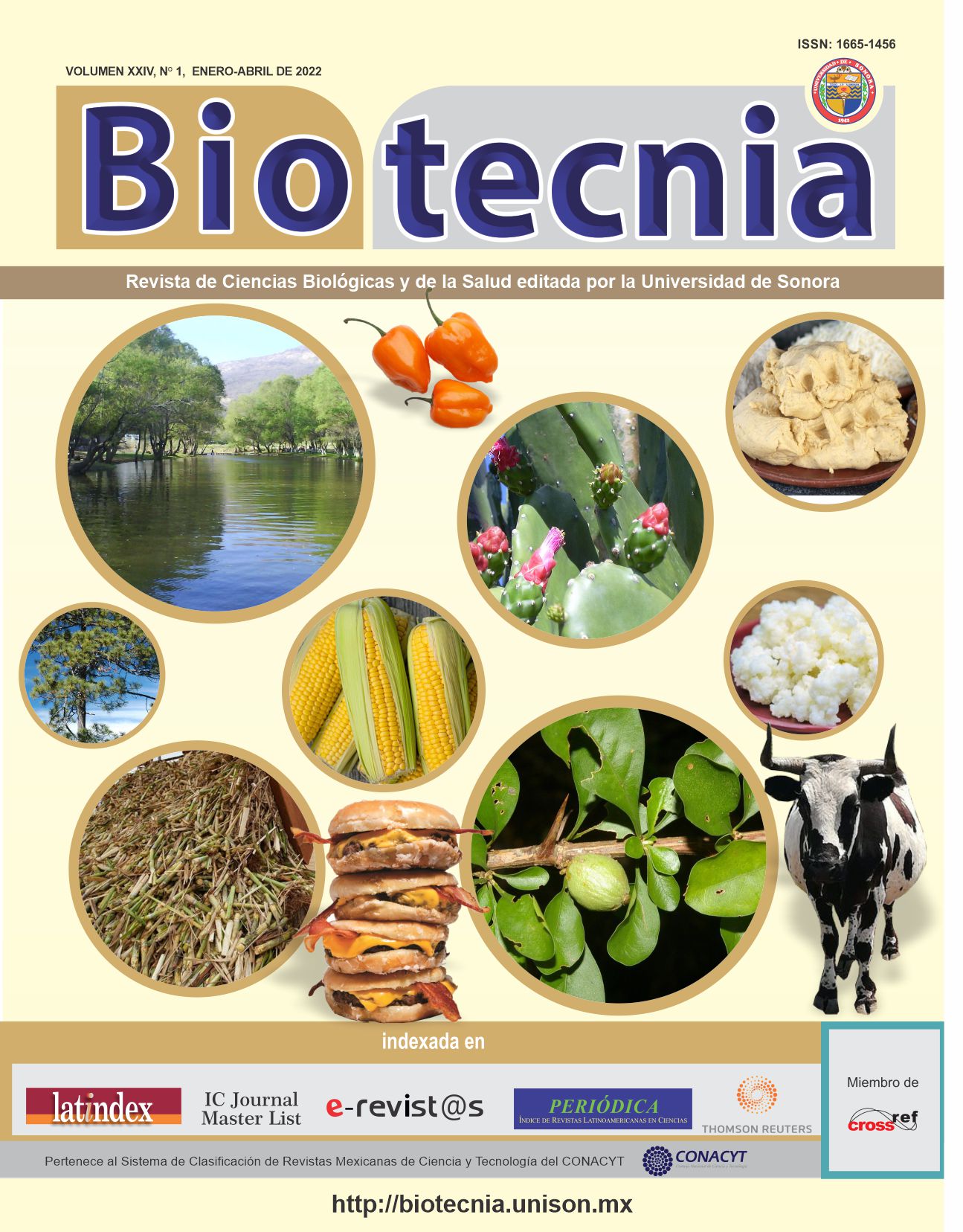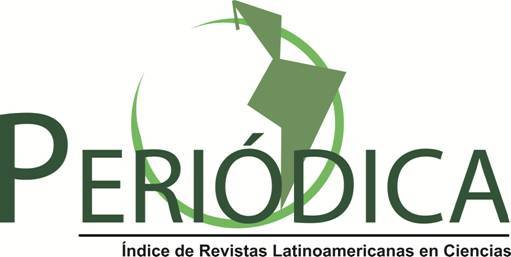Use of Aloe vera gel in Capsicum chinense seedlings production
DOI:
https://doi.org/10.18633/biotecnia.v24i1.1542Keywords:
Phytohormone, sabila , habanero pepper, imbibitionAbstract
The production of habanero pepper in Yucatán demands quality seedlings at the time of transplantation, which has led to the use of growth regulators, which, although it is true, potentiate the germination and development of the plants, they also increase production costs. For this reason, production alternatives are being sought that reduce costs, which is why an eye has been focused on Aloe vera gel, whose chemical composition reports the presence of phytohormones such as gibberellins and salicylic acid. To study the response of the aloe gel in the emergence and development of the root and shoot in habanero pepper seedlings, 500 seeds of the habanero pepper variety "Mayapan" were sown, in groups of 100, previously soaked in 100 mL of aloe gel. at 0, 2.5, 5, 10 and 20%, for 24 h. The results obtained show that Aloe vera gel reduces emergence by four days and favors root development, plant height and total fresh biomass by up to 18%; 11% the diameter of the stem and 13% number of leaves, observing a greater effect with the 5% solution of Aloe vera gel.
Downloads
References
Adame-García, J., Murillo-Cuevas, F.D., Flores-de la Rosa, F.R., Velázquez-Mendoza, V., López-Vázquez, M., Cabrera-Mireles, H. y Antonio-Vázquez, E. 2021. Identificación molecular y evaluación de bacterias en el desarrollo vegetativo y producción de chile habanero. Biotecnia. 23(3): 151-157.
Alcántara, C.J.S., Acero, G.J., Alcántara, C.J.D. y Sánchez M.R.M. 2019. Principales reguladores hormonales y sus interacciones en el crecimiento vegetal. NOVA. 17: 109-129.
Boschi, C.L., Gandolfo, E. y Vence, L. 2017. Evaluación de gel de Aloe vera en el enraizamiento de estaquillas de orégano (Origanum vulgare). Horticultura Argentina. 36(89): 06-16.
Castillo-Aguilar, C. de la C. 2018. Producción de planta de chile habanero (Capsicum chinense Jacq.). Agro Productividad. 8(4): 73-78.
Castro, R.J.J., Solís, O.M.M., Castro, R.R. y Calderón, V.C.L. 2019. Minireview: Uso de fitorreguladores en el manejo de cultivos agrícolas. Frontera biotecnológica. 13(3): 14-18.
Carranza-Álvarez, C., Trinidad-García, K.L., Reyes-Hernández, H., Castillo-Pérez L.J. y Fortanelli-Martínez, J. 2021. Efecto de extractos orgánicos naturales sobre la micropropagación de Vanilla planifolia Jacks. ex Andrews (Orchidaceae). Biotecnia. 23(1): 5-12.
DOF. 2010. Declaratoria general de protección de la denominación de origen del chile habanero de la península de Yucatán. [Consultado 30 julo 2020]. Disponible en: http://dof.gob.mx/nota_detalle.php?codigo=5145315&fecha=04/06/2010
Domínguez-Fernández, R.N., Arzate-Vázquez, I., Chanona-Pérez, J.J., Welti-Chanes, J.S., Alvarado-González, J.S.A., Calderón-Domínguez, G., Garibay-Febles, V. y Gutiérrez-López, G.F. 2011. El gel de Aloe vera: Estructura, Composición química, procesamiento, actividad biológica e importancia en la industria farmacéutica y alimentaria. Revista Mexicana de ingeniería química. 11(1): 23-43.
Dzib-Ek, G., Villanueva-Couoh, E., Garruña-Hernández, R., Vergara, Y.S. y Larqué-Saavedra, A. 2021. Efecto del ácido salicílico en la germinación y crecimiento radicular del tomate. Revista Mexicana de Ciencias Agrícolas, 12(4): 735-40.
Echevarría-Machado, I., Escobedo G.M. and Larqué-Saavedra A. 2007. Responses of transformed Catharanthus roseus roots to femtomolar concentrations of salicylic acid. Plant physiol. Biochem. 45: 501-507.
Flores, L.M.L. y Sánchez, O.E. 2020. Entorno productivo del chile habanero en la Península de Yucatán, México. En Metabolómica y cultivo del chile habanero (Capsicum chinense Jacq) de la Península de Yucatán (332). Mérida, Yucatán: CIATEJ.
González, T.E., Zúñiga, A.J. y Vázquez, F.F. 2018. Mejoramiento genético del chile habanero de la Península de Yucatán. CONACYT. Mérida, Yucatán, México. pp17-21.
Gutiérrez-Coronado, M.A., Trejo-López, C. and Larqué-Saavedra, A. 1998. Effects of salicylic acid on the growth of roots and shoots in soybean. Plant Physiol. Biochem. 36: 563-565.
Larqué-Saavedra A., Martín-Mex R., Nexticapan-Garcéz, A., Vergara-Yoisura S. y Gutiérrez-Rendón, M. 2010. Efecto del ácido salicílico en el crecimiento de plántulas de tomate (Lycopersicon esculentum Mill.). Rev. Chapingo Ser. Hortic. 16: 183-187.
Li, G., Liu, S., Sun, Z., Xia, L., Chen, G. y You, J. 2015. A simple and sensitive HPLC method based on pre-column fluorescence labelling for multiple classes of plant growth regulator determination in food samples. Food Chemistry. 170: 123-130.
Lu, H., Greenberg, J.T. and Holuigue, L. 2016. Salicylic Acid Signaling Networks. Front. Plant Sci 7: 238. doi: 10.3389/fpls.2016.00238.
Mendoza-Paredes, J.E., Castillo-González, A.M., Avitia-García, E., Valdez-Aguilar, L.A. y García-Mateos, M.R. 2021. Efecto de diferentes proporciones de luz, led azul: roja en plantas de chile habanero (Capsicum chinense Jacq.). Biotecnia. 23(1): 110-119.
Preciado, R.P., Baca, G.A, Tirado, J.L., Kohashi-Shibata, J., Tijerina, L., Martínez, A. 2002. Nitrógeno y potasio en la producción de plántulas de melón. Terra. 20:267-276.
Pita, V.J.M y Pérez, G.F. 1998. Germinación de semillas. Ministerio de Agricultura Pesca y Alimentación. Hojas divulgadoras/Número 2090 HD. Madrid España.
Pulido, S.N. y Becerra, A.J.L. 2016. Aloe vera (Aloe barbadensis Miller) en la regeneración de explantes de Agra (Vaccinium meridionale Swartz). Cultura científica. 14: 58-68.
Ramírez-Luna, E., Castillo-Aguilar C. C., Aceves-Navarro E. y Carrillo-Ávila, E. 2005. Efecto de productos con reguladores de crecimiento sobre la floración y amarre de fruto en chile ‘habanero’. Revista Chapingo Serie Horticultura. 11(1): 93-98.
Rodríguez-Larramendi, L.A., González-Ramírez, M., Gómez-Rincón, M.A., Guevara-Hernández, F., Salas-Marina, M. A. y Gordillo-Curiel, A. 2017. Efectos del ácido salicílico en la germinación y crecimiento inicial de plántulas de frijol (Phaseolus vulgaris L.). Revista De La Facultad De Agronomía De La Universidad Del Zulia. 34(3): 253-269.
San Miguel, R., Gutiérrez M., Larqué-Saavedra, A. 2003. Salicylic acid increases the biomass accumulation of Pinus patula. Southern Journal of Applied Forestry. 27: 52-54.SAS, 2004. Statistical Analysis System Institute. SAS Proceeding Guide, Version 8.1. SAS Institute. Cary, NC. USA
Shakirova, F.M., Sakhabutdinova A.R., Bezrukova M.V., Fatkhutdinova R.A. and Fatkhutdinova, D.R. 2003. Changes in the hormonal status of wheat seedlings induced by salicylic acid and salinity. Plant Sci. 164: 317-322.
SIACOM-NG. 2020. Módulo agrícola estatal. [Consultado 30 julio 2020]. Disponible en https://www.gob.mx/siap/documentos/siacon-ng-161430
SIAP. 2020. Panorama agroalimentario 2020. [Consultado 30 julio 2020] Disponible en: https://nube.siap.gob.mx/gobmx_publicaciones_siap/pag/2020/Atlas-Agroalimentario-2020
Tucuch-Haas, C.J., Alcántar-González, G., Volke-Haller, V.H., Salinas-Moreno, S., Trejo-Téllez, L.I. y Larqué-Saavedra, A. 2016. Efecto del ácido salicílico sobre el crecimiento de raíz de plántulas de maíz. Revista Mexicana de ciencias agrícolas. 7: 709-716.
Villanueva-Couoh, E., Alcántar-González, G., Sánchez-García, P., Soria-Fregoso M. y A. Larqué-Saavedra. 2009. Efecto del ácido Salicílico y dimetilsulfóxido en la floración de Chrysanthemun morifolium (Ramat) Kitamura en Yucatán. Rev. Chapingo Ser. Hortic. 15: 25-31.
Downloads
Published
How to Cite
Issue
Section
License
Copyright (c) 2022

This work is licensed under a Creative Commons Attribution-NonCommercial-ShareAlike 4.0 International License.
The journal Biotecnia is licensed under the Attribution-NonCommercial-ShareAlike 4.0 International (CC BY-NC-SA 4.0) license.





_(1)_(1).png)






_(2).jpg)





